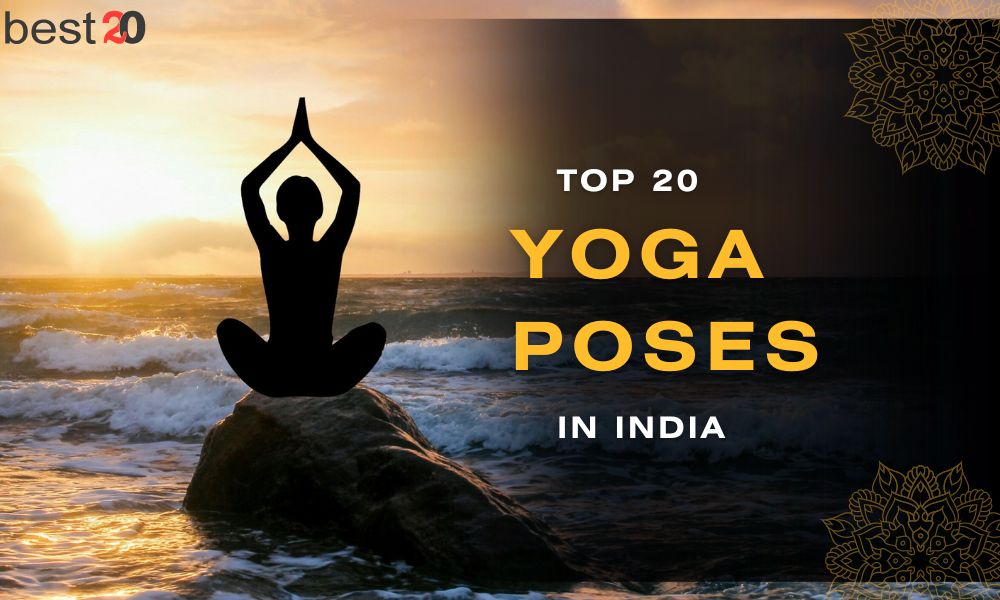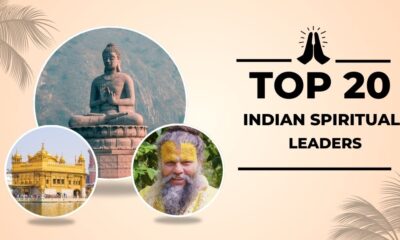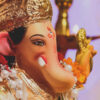Top 20
Top 20 Yoga Poses (Asanas) In India
The quantity of positions may seem difficult to a beginner student of yoga, but yoga does not have to be difficult. You have already performed a yoga poses if you rolled out of bed this morning and crossed your arms over your head. Yoga is a lifetime activity that allows you many chances to experiment with every asana (position) and master poses in order.
Since our bodies naturally bend and fold into many basic yoga positions they seem familiar. To relax and get deeper into poses it is also beneficial to pay attention to your breathing. You may develop into more difficult yoga postures by starting with these beginner poses which will also introduce you to the discipline. In this blog we are going to discuss about top 20 yoga poses.
Also Read (Top 20 Most Popular Sports in India)
Yoga Asanas for Beginners
Here we are going to discuss yoga asanas with pictures and names:
1. Tadasana (Mountain pose)
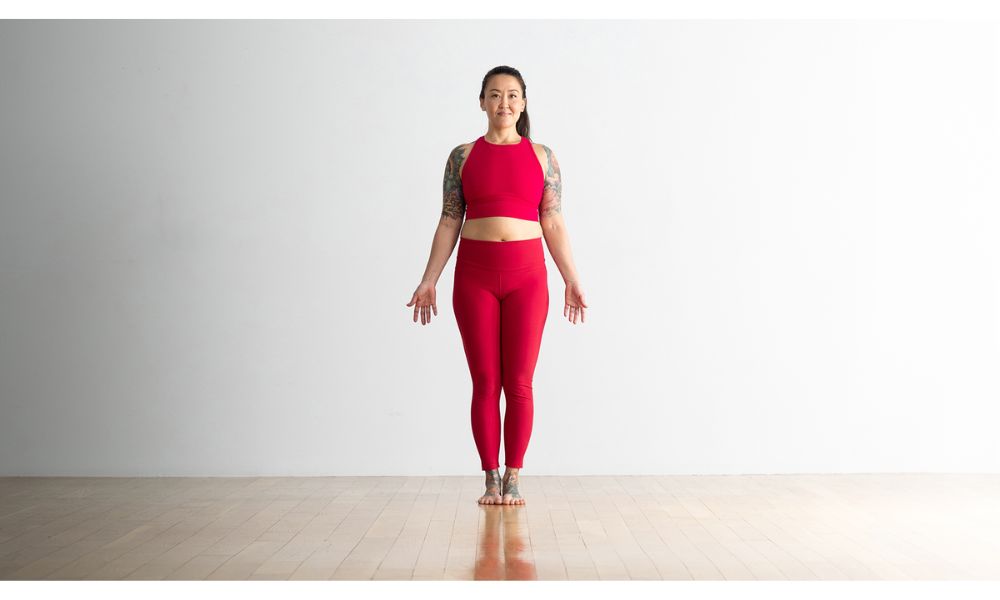
This easy yoga stance teaches you to stand with majestic steadiness like a mountain. The name is derived from the word ‘Tada’ which means mountain. Mountain Pose is the foundation for all standing poses it works for the major muscular groups and increases attention and concentration. Mountain posture may appear to be “simply standing” yet there is a lot more going on there.
Benefits
- Improves Posture
- Strengthens Core Muscles
- Enhances Balance and Stability
- Improves Circulation
2. Vrikshasana (Tree pose)
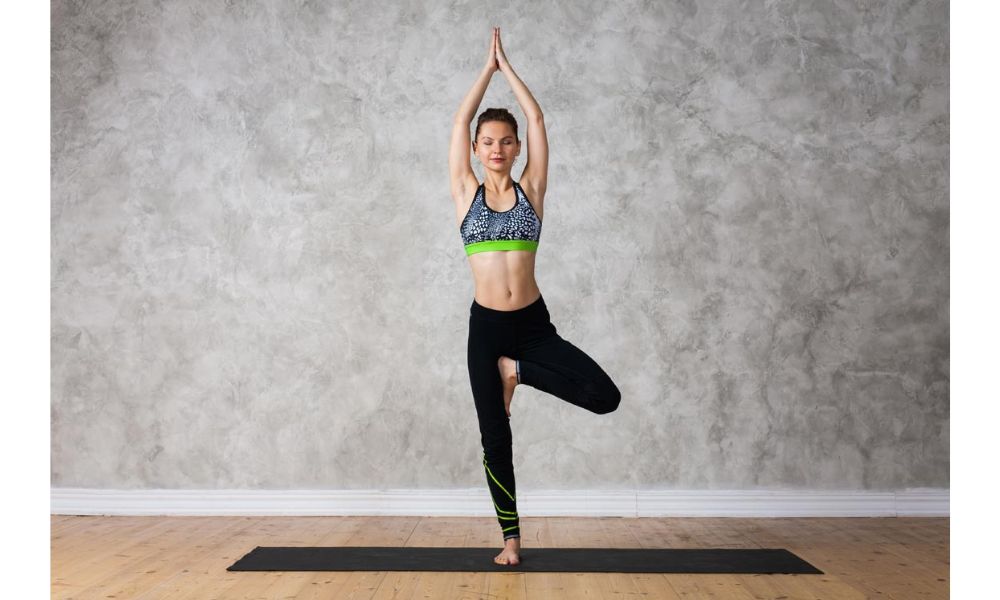
The Tree position helps to balance and relax the mind. This yoga stance is beneficial because it promotes constant and healthy cardiac function, which is a result of mental peace. Beginners can enhance their ability to breathe and maintain body balance on one foot as well as their clarity and focus by doing the wonderful standing balance practice known as Tree. It mimics the steady stance of a tree.
Benefits
- Improves Balance and Stability
- Strengthens Legs and Core
- Enhances Flexibility
- Stimulates Circulation
3. Utthita Hastapadasana (Extended Hands and Feet Pose)
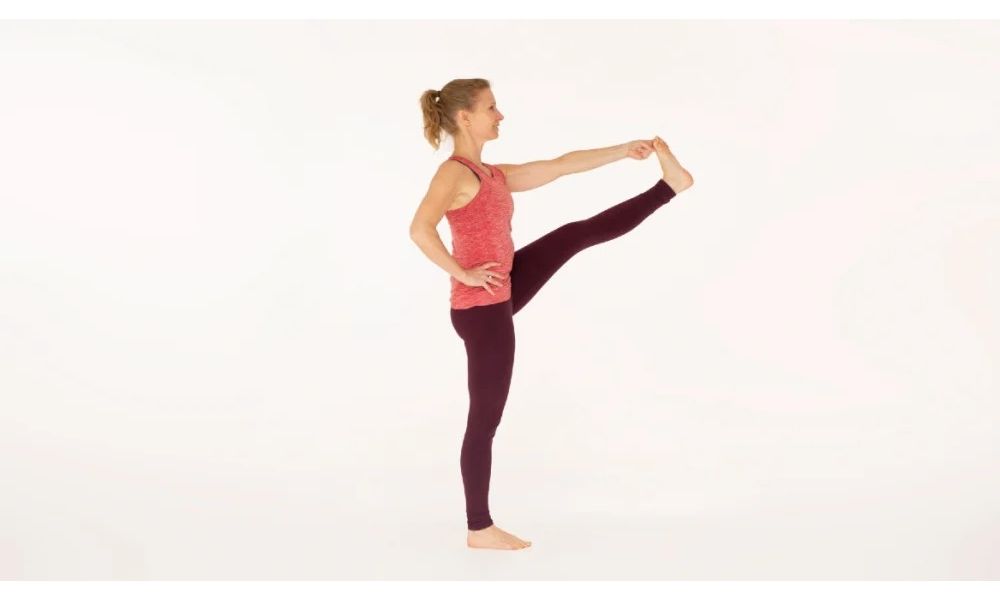
An alternative to putting your hand on the floor in an Extended Side Angle Pose is to bring your forearm up to your thigh. It should not be very heavy and should just barely lay on your thigh. With this adjustment, you can maintain an open shoulder posture. Alternatively you might rest your hand on a yoga block. Reaching for the floor before you are ready could cause you to misalign the shape of your body turning your chest to face the floor rather than toward the sky.
Benefits
- Stretches the Hamstrings and Calves
- Strengthens the Legs and Core
- Improves Balance and Coordination
- Opens the Hips
- Promotes Better Posture
4. Trikonasana (Triangle pose)

If you are uncomfortable extending your arm to the floor in this yoga pose you can modify the Triangle in the same way as the Extended Side Angle by utilizing a yoga block for your bottom hand. Alternatively you can place your hand higher up on your leg such as on your thigh or shin but keep it away from your knee. If this yoga stance feels uncomfortable do not be afraid to microbend both knees. It will feel and look more like a slight bend just enough movement to release your knees and release tension in your hamstrings.
Benefits
- Stretches and Strengthens Muscles
- Improves Flexibility
- Promotes Core Strength
- Stimulates Organs
- Enhances Spinal Health
- Improves Balance and Coordination
5. Virabhadrasana (Warrior pose)
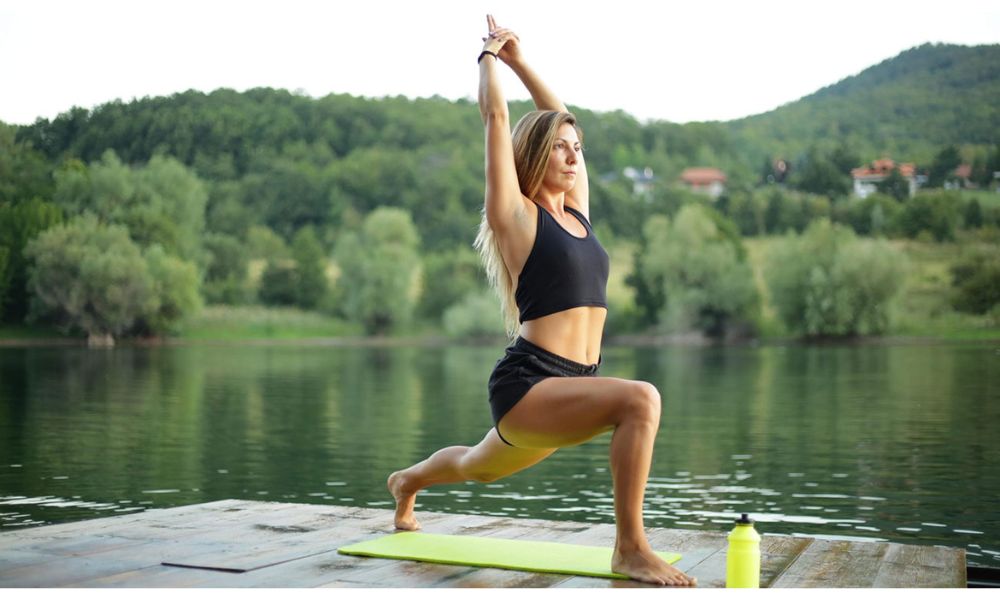
In yoga Virabhadrasana commonly referred to as the Warrior position is a strong and dynamic asana that represents the bravery, strength, and resolve of the legendary warrior Virabhadra. With one foot going forward and the other back to provide a sturdy, secure foundation the feet should be firmly placed on the ground to start this standing pose. The arms stretch overhead, forming a wide, heroic shape that exudes focus and force as the torso bends to face the front leg.
Benefits
- Strengthens Muscles
- Improves Balance and Stability
- Enhances Flexibility
- Increases Endurance
- Promotes Better Posture
6. Utkatasana (Chair pose)
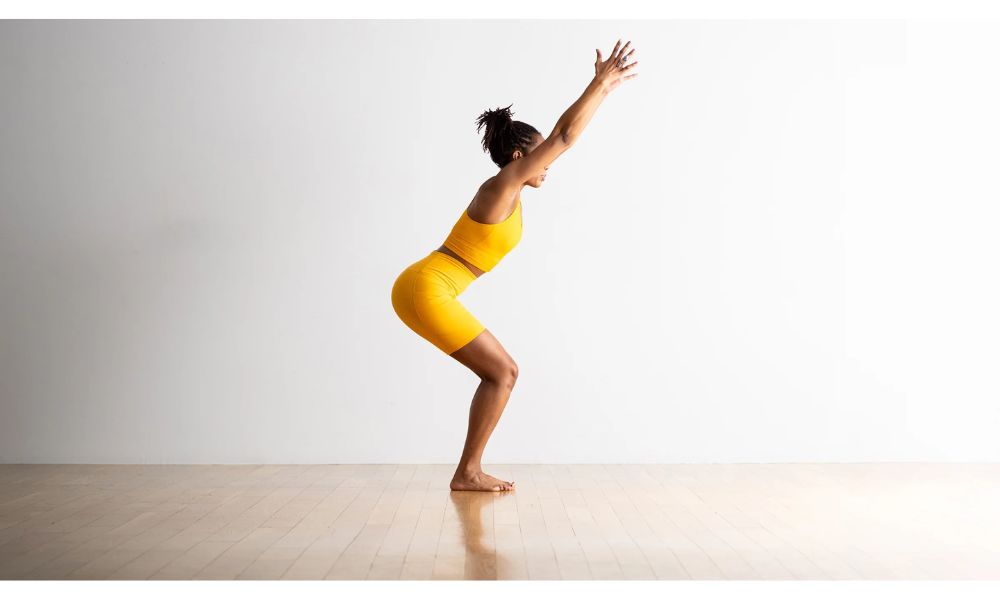
Utkatasana is a powerful and engaging yoga asana. This standing position tests the practitioners strength, balance, and mental attention as they stoop down bending at the hips and knees to sink the seat back as if sitting in an unseen chair. The legs work hard to support the body weight the core engages to keep the posture erect and the arms can stretch overhead or out in front creating length in the torso and a sense of expansion. Utkatasana demands the yogi to maintain balance and poise in what can feel like an unstable perilous position.
Benefits
- Strengthens the Legs
- Engages the Core
- Improves Posture
- Stimulates Circulation
7. Marjariasana (Cat pose)
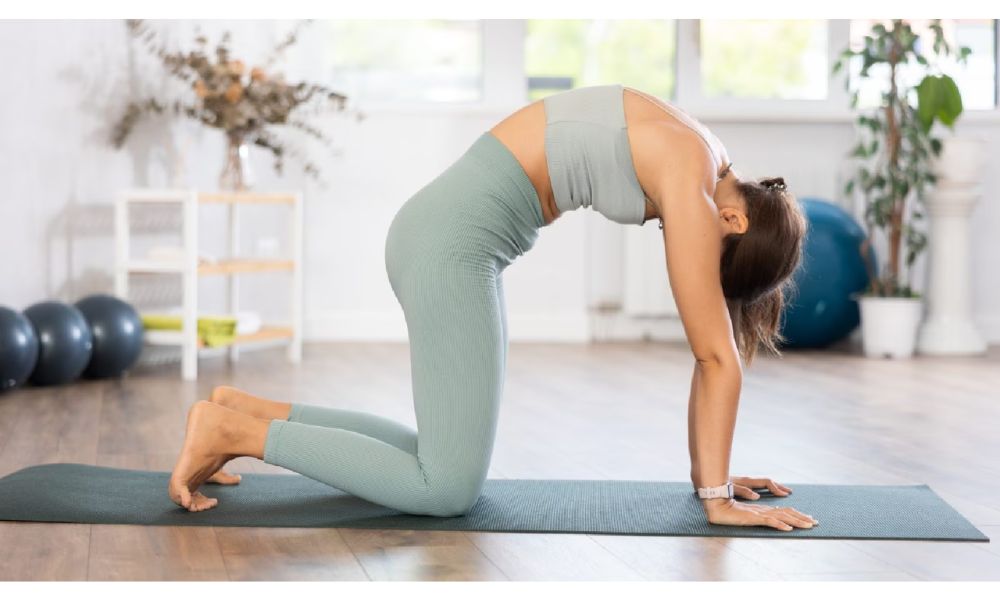
Marjariasana also known as the Cat Pose is a basic yoga posture that gently stretches and mobilizes the spine. Beginning on all fours the practitioner gently arches their back upwards, curving the spine and pulling the navel in towards the spine to mimic a feline natural movement. As they inhale the chest rises and the gaze shifts slightly forward lengthening the neck and opening up the front of the body.
Benefits
- Increases Spinal Flexibility
- Stretches and Strengthens the Back
- Relieves Back Pain
- Improves Posture
- Stimulates the Abdominal Organs
8. Adho Mukho Svanasana (Downward facing dog pose)

It is not always simple to practice downward dog even if you have heard of it. This stance resembles a plank more than it does a forward bend which is common among beginners. Rather maintain most of your weight in your legs and raise your hips while extending your heels toward the floor. If your hamstrings are tight soften your knees to help with the exercise. Maintain parallel feet.
Benefits
- Strengthens and Stretches the Whole Body
- Improves Core Strength
- Enhances Flexibility
- Alleviates Back Pain
- Promotes Better Posture
9. Bhujangasana (Cobra pose)
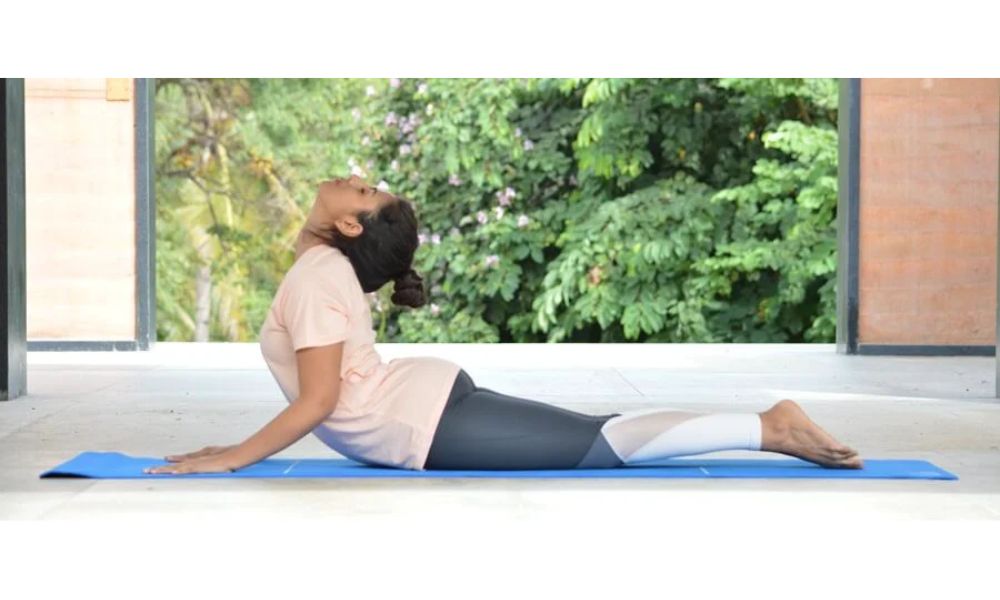
Cobra is one of the basic poses in flow yoga performed several times in a session. Although a full cobra with straight arms provides a deeper backbend low cobras where you raise your chest without pressing into your hands will strengthen your back more. As you raise the sternum anchor yourself in your feet extend through the top of your head and widen through your collarbones. Anchoring your hips to the floor before lifting is also very important.
Benefits
- Strengthens the Spine
- Stretches the Chest and Abdominals
- Improves Posture
- Stimulates Abdominal Organs
- Increases Flexibility
10. Dhanurasana (Bow pose)
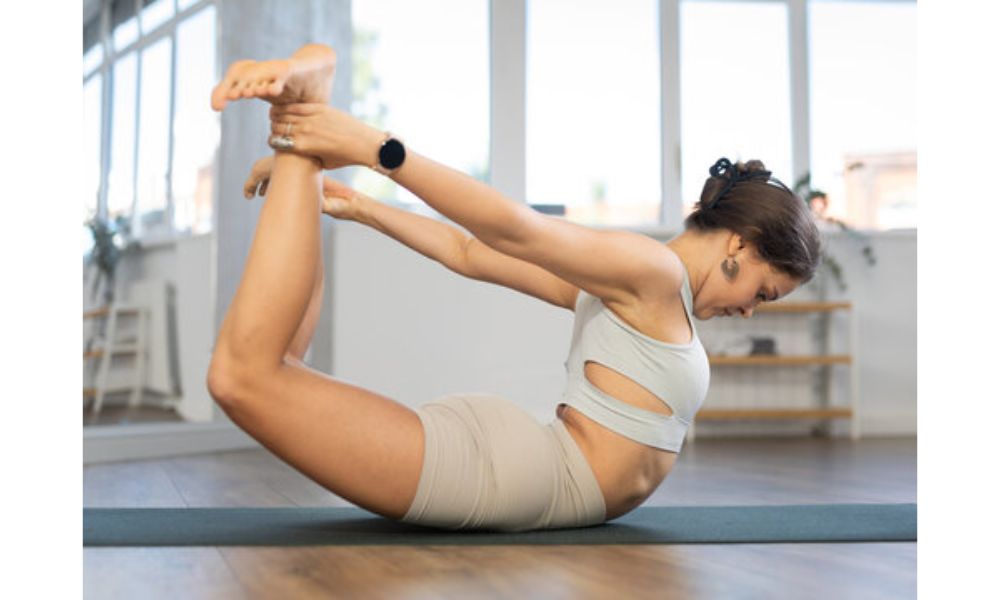
Dhanurasana also known as the Bow Pose is a backbending yoga asana that stretches the front of the body while strengthening the back. To perform this posture the practitioner lies face down on the mat, bends their knees, and reaches back to grip the ankles or tops of their feet. As they inhale they raise their thighs and chest off the floor arching the spine and pushing the shoulders back to make a bow shape with the body. The head may tilt back slightly with the gaze directed toward the ceiling.
Benefits
- Strengthens the Back
- Stretches the Front Body
- Improves Posture
- Stimulates Digestive Organs
- Enhances Spinal Flexibility
11. Setu Bandhasana (Bridge pose)

Setu Bandhasana commonly known as the Bridge Pose is a powerful backbend that provides numerous physical and mental advantages. This dynamic asana starts with the practitioner lying on their back, legs bent, and feet flat on the ground. From here they use the core muscles to pull the hips up towards the sky forming an arched bridge with the body. The hands can either stay on the floor to support the lift or clasp together beneath the back for increased challenge and stability.
Benefits
- Reduces Stress and Anxiety
- Improves Mood
- Increases Energy Levels
12. Salamba Sarvangasana (Half Shoulder stand)
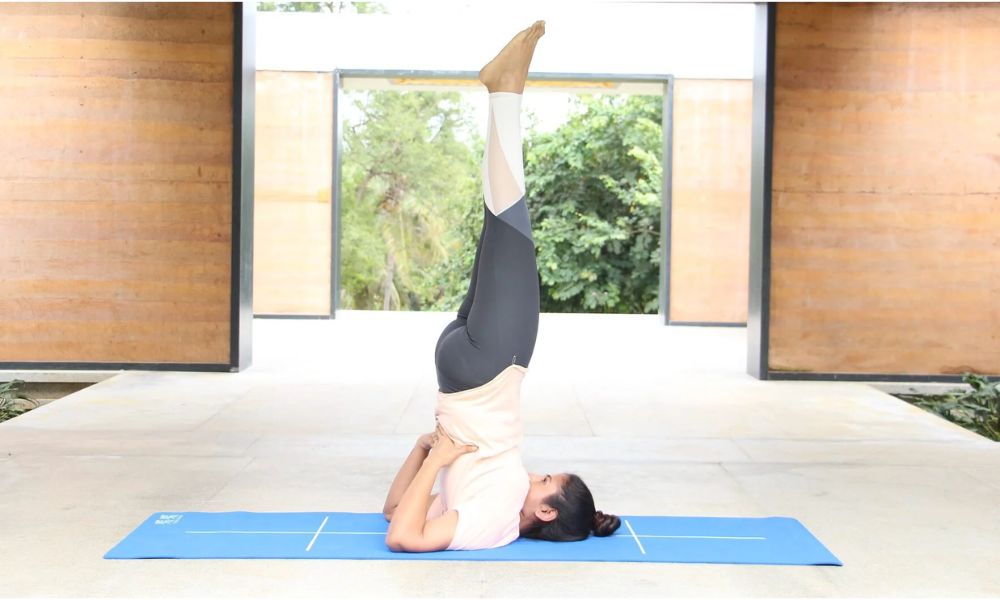
Salamba Sarvangasana, also known as the Supported Shoulderstand, is a well-known and restorative yoga pose that provides numerous physical and mental benefits. This inversion, which translates as “supported all limbs pose” starts with the practitioner lying on their back legs stretched toward the ceiling. The hips are then hoisted up with the hands allowing the body to assume an inverted V configuration with the upper back and shoulders supporting the weight.
Benefits
- Strengthens the Core and Upper Body
- Stretches the Neck and Shoulders
- Improves Digestion
- Enhances Flexibility
13. Ardha Matsyendrasana (Sitting Half Spinal Twist)
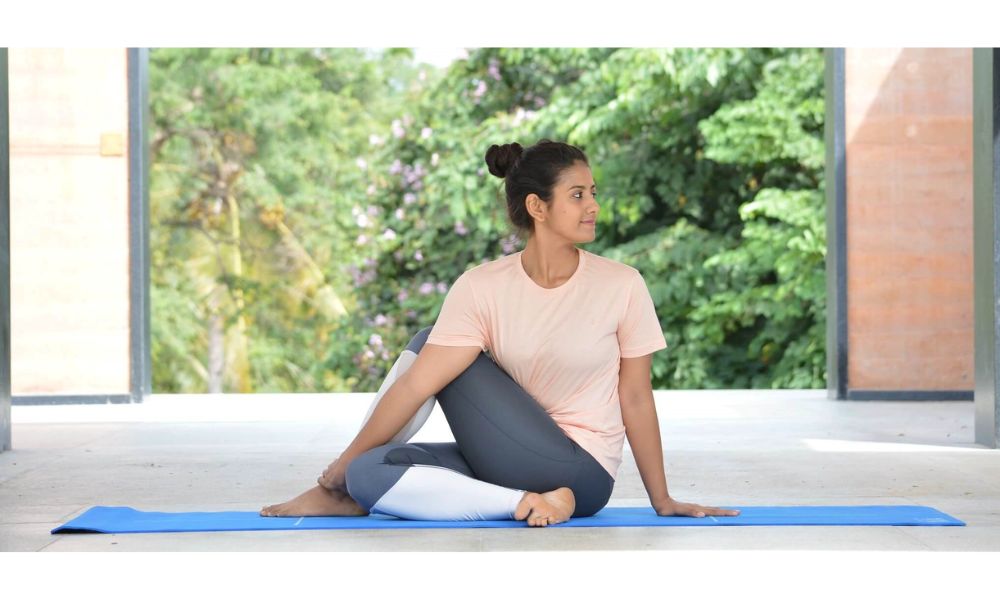
In yoga twists are a vital component. Twists can alleviate constipation by promoting movement along the digestive tract and enhancing spine mobility. If you find it uncomfortable to have your lower leg bent behind you in this yoga pose feel free to lengthen it. Another way to change it is to take a seat on a blanket. It is very beneficial to reduce rotation of the spine, hips and shoulders by putting the bent leg inside the extended leg.
Benefits
- Improves Spinal Flexibility
- Strengthens the Core
- Stimulates Digestive Organs
- Increases Circulation
- Detoxifies the Body
14. Paschimottanasana (Two-legged forward bend)
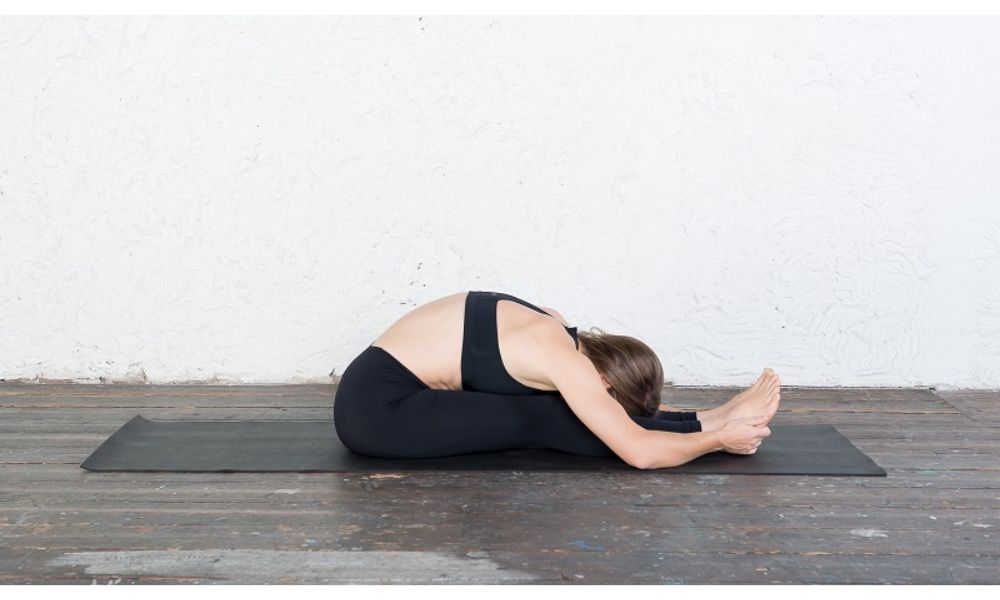
There is good reason why beginner yoga poses include a lot of hamstring stretches. People who spend a lot of time sitting down tend to have short tight hamstrings which can exacerbate lower back pain. It is beneficial to stretch them similarly to the Seated Forward Bend. The entire back of the body is stretched in this stance. Maintain a neck that is in line with your spine and bend at the hips rather than the waist.
Benefits
- Stretches the Hamstrings and Lower Back
- Improves Posture
- Stimulates the Digestive System
- Calms the Mind
15. Dandasana (Stick pose)
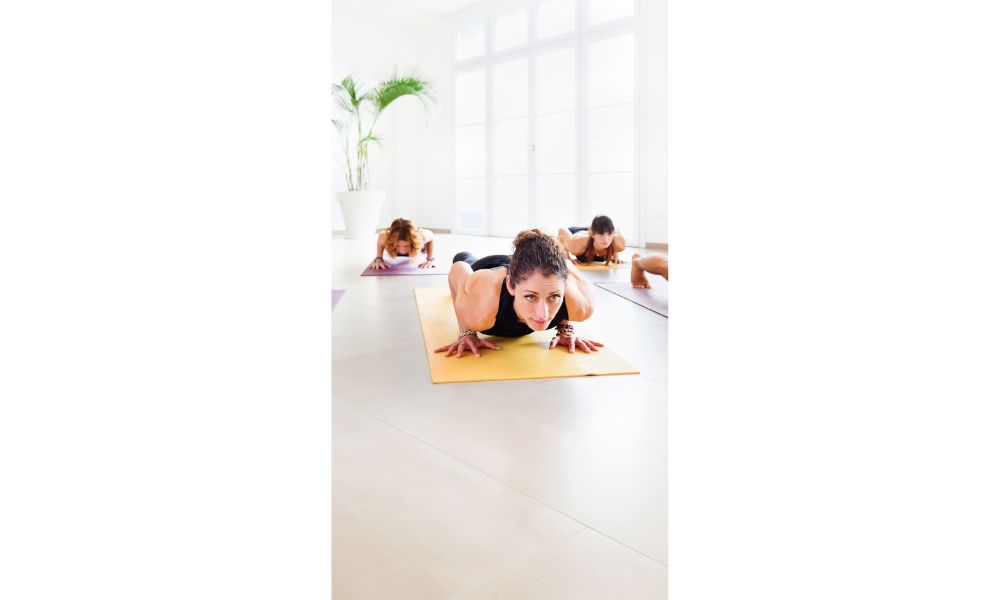
Although there is very little chance of falling it may seem odd to refer to the plank stance as a balancing pose yet this name highlights the fundamental strength of the pose. Planking is a great technique to build your stability and stamina. A strong core is necessary for many yoga postures including standing and arm balances. Maintain a neutral posture for your hips and spine.
Benefits
- Strengthens the Core
- Improves Posture
- Enhances Flexibility in the Legs
- Stretches the Spine
16. Dolphin pose
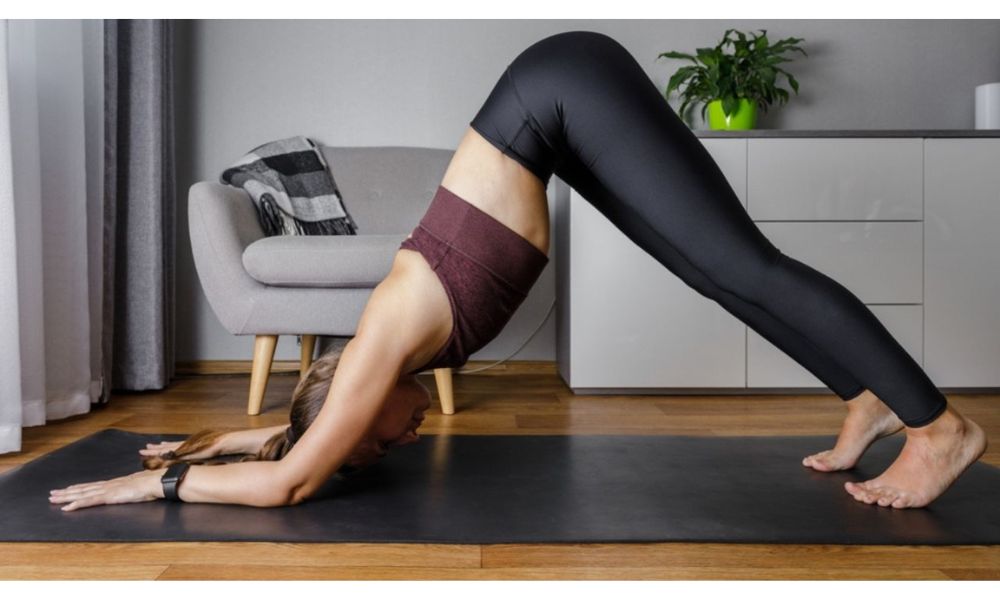
Dolphin pose a popular yoga asana, is a dynamic and energizing posture that provides several mental, physical and spiritual advantages. This inverted arm balance often known as the “baby brother” of the handstand, requires intense engagement of the core, shoulders and posterior chain in order to raise the hips and stretch the spine. As you step or hop your feet back into the position your palms firmly press into the mat, stimulating the arm and upper back muscles to support your bodyweight.
Benefits
- Strengthens the Shoulders
- Enhances Core Strength
- Stretches the Hamstrings and Calves
- Improves Spinal Flexibility
- Strengthens the Upper Body
17. Dolphin Plank pose

The Dolphin Plank pose is a difficult yet rewarding yoga position that involves tremendous core strength, balance, and flexibility. Starting on all fours, the practitioner walks their feet back until their body forms a straight line from heels to head supported by their forearms and toes. The elbows are just below the shoulders forming a triangle configuration with the arms. As the core works to keep the body in a solid plank, the gaze is slightly forward, the neck is long and neutral, and the legs are stretched with the heels extending back.
Benefits
- Strengthens the Core
- Builds Upper Body Strength
- Enhances Shoulder Stability
- Improves Posture
- Boosts Endurance
18. Sphinx pose

Sphinx position also called Salamba Bhujangasana is a beginner friendly backbend that gradually expands the chest and front of the body. To begin this posture the yogi lies face down on the mat with legs outstretched and the tops of the feet resting on the floor. They next press their palms into the mat beside their shoulders using their back and arm muscles to gradually elevate the chest, head, and neck off the floor. The gaze is soft, and the shoulders are brought back to form a mild backbend in the upper back.
Benefits
- Strengthens the Lower Back
- Stretches the Spine
- Opens the Chest and Shoulders
- Stimulates Abdominal Organs
19. Shavasana (Corpse pose)
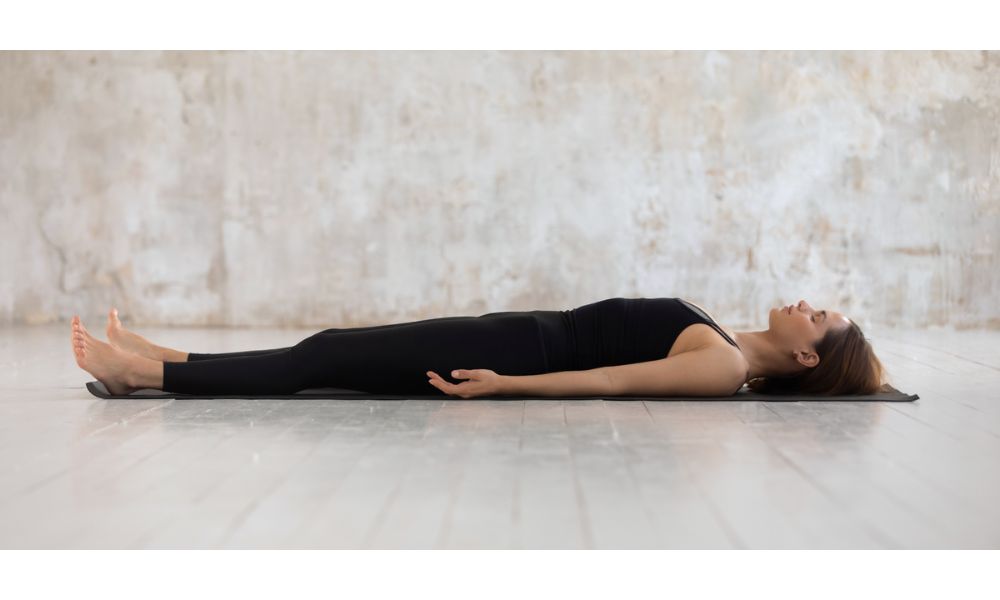
Shavasana commonly known as the Corpse Pose is a fundamental resting pose in yoga that allows the body and mind to relax and restore. This basic yet profoundly impacting pose is frequently held at the end of a yoga session, giving the practitioner an important time to fully assimilate the benefits of their practice. Shavasana which involves lying flat on one’s back with limbs gently splayed outward, promotes the release of physical, mental, and emotional tension allowing the mind to calm its continual chatter and the body to fall into a state of deep tranquility.
Benefits
- Deep Relaxation
- Mental Clarity
- Restores Energy
- Improves Sleep
20. Anjali Mudra
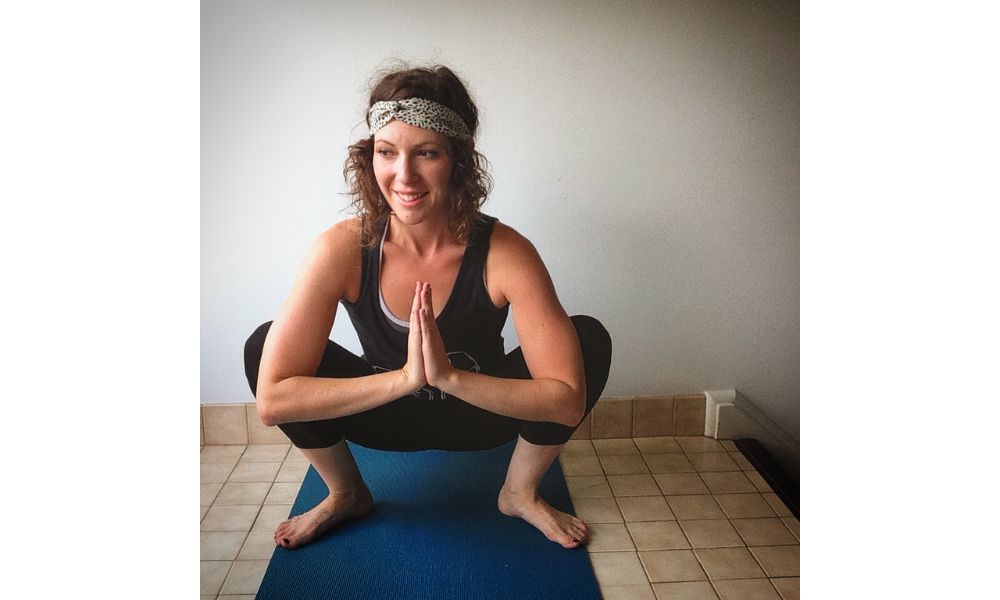
The Anjali Mudra is a simple yet powerful hand gesture with profound spiritual meaning in many Eastern faiths. This mudra also known as the Namaste or Prayer Pose is performed by bringing the palms of the hands together at the heart center and pointing the fingers upwards. The term “Anjali” means “offering” or “reverence” and completing this mudra is considered a way to venerate the divine, the holy or the inherent worth in all beings.
Benefits
- Promotes Mindfulness and Centering
- Enhances Breath Awareness
- Encourages Calmness
- Fosters a Sense of Connection:
Conclusion
After exploring the top 20 yoga poses in India we discover a wide and complex tapestry of old physical, mental, and spiritual practices that have survived for generations. From the elegant flow of the Dolphin pose to the firm stability of Vrikshasana, or Tree Pose these asanas exemplify yoga’s comprehensive nature as a road to body mind harmony. Each pose whether stimulating like Chaturanga Dandasana or soothing like Savasana the Corpse Pose has a unique purpose such as targeting certain muscle areas, strengthening flexibility, or creating focused awareness.

